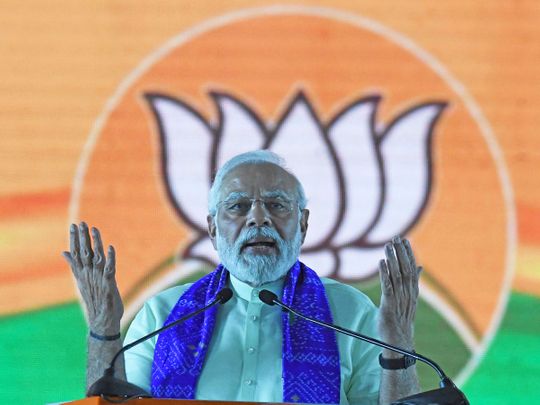
The Bharatiya Janata Party’s coup in Maharashtra has regional satraps worried. They see the BJP as a predatory force, gobbling up smaller, regional parties in its relentless march to power in state after state. For Telangana’s two-time Chief Minister Kalvakuntla Chandrashekar Rao, better known as KCR, the threat posed by BJP to Telangana Rashtra Samithi (TRS), a party that he founded and led to power, and to his chief minister-ship is only too real. An experienced politician and leader like KCR would never underestimate BJP’s mission south. He knows that it may even be a battle for his survival.
The BJP’s two-day national executive meeting, which began on July 3 in Hyderabad, the capital of Telangana, was significantly titled “Vijay Sankalpa Sabha”, or Victory Resolve Gathering. Bhagyanagar, the city’s original name, means city of fortune. Can there be any doubt that the BJP, led by Narendra Modi, is set to stake its claim to the political fortune that the state represents in the party’s push southwards? The fact that the BJP chose Hyderabad after 18 years for its annual gathering is the sounding of a bugle or battle cry.
India’s ruling party mobilised a mammoth rally of 1 million people, which was addressed by India’s Prime Minister Narendra Modi, at the Parade Grounds in Secunderabad, which is Hyderabad’s twin city. Besides Modi, around 300 top-notch BJP leaders were present, including party bosses such as Home Minister Amit Shah, Defence Minister Rajnath Singh, party president J. P. Nadda, and Uttar Pradesh Chief Minister Yogi Adityanath.
Targeting women, farmers, youth, and other sections of society, Modi promoted the UP model of the “double-engine” government, with the centre and the state ruled by the same party.
In addition, chief ministers or their deputies of 14 BJP-ruled states were present. As Modi’s speech on Sunday evening clearly showed, capturing power in Telangana, which goes to the polls next year, was very much on the agenda. This was indicated by 34 committees formed to oversee the agenda for the meeting and the party. In fact, Nadda had instructed attendees to conduct a mass-contact programme in the state’s 119 assembly constituencies ahead of the meeting. To promote and publicise the schemes and achievements of the central government and BJP-ruled state governments was the plan so that the party becomes attractive to Telangana voters.
Much of Modi’s short speech on Sunday emphasised BJP’s plans and promises for the state. He spoke of the government’s flagship schemes, including Ujwala Yojana to provide free LPG connections and cooking gas cylinders to the poorest; Ayushman Bharat, a health scheme for ration card holders; the free vaccination programme against the COVID-19 virus; highways, educational institutions, incentives to Cyberabad tech city; and the 31,000-crore rupees ((310 billion rupees, ie Dh14.4 million) worth of projects the central government has sanctioned in the state, including a textile park.

He also spoke of the culture, poetry, bravery, and sacrifice of the people. Targeting women, farmers, youth, and other sections of society, Modi promoted the UP model of the “double-engine” government, with the centre and the state ruled by the same party. Modi reminded his adulatory crowd of his party’s motto of “Sab ka saath, sab ka vikaas, sab ka vishwas, aur sab ka prayaas” —everyone’s support, everyone’s progress, everyone’s confidence, and everyone’s efforts — to make the state grow to greater heights.
Will the party try to consolidate Hindu votes in the state to upset the KCR and TRS applecart? That certainly seems part of the plan, with Yogi Adityanath going to the Bhagya Laxmi temple at the heart of the old city, near Charminar. This is the stronghold of the All India Majlis-e-Ittehadul Muslimeen (AIMIM), with a sizeable concentration of Muslim voters. That a very large crowd showing up to support Adityanath was a clear signal that the BJP was counting on a massive Hindu mobilisation. Modi’s references to Telangana’s famous temples, including ancient shrines in Bhadrachalam, Vemulakonda Gutta, and Warangal, is another sign of this plan.
But what must have worried KCR the most was Modi’s caustic criticism of dynastic parties during his last visit to the state on May 27. The reference was not only meant for the Congress, much weakened but still very much under the control of the Gandhi family, but also to TRS, AIMIM, and other regional parties, which are more or less fiefdoms of single families. Modi said that dynastic politics was not only a political irritant but also the enemy of democracy: “In the 21st century, hereditary politics is a major impediment to development.”
The BJP rules only one southern state, Karnataka. That they would like to increase their footprint in Telangana is therefore clear. What is, however, not clear is what KCR will come up with to counter the BJP campaign. Appealing to regional sentiments will be an obvious ploy. But will it work this time?
The voters in the state may well want a change after nearly ten years and two terms to TRS. Anti-incumbency for KCR will be harder to offset in 2023, when he goes to the hustings for a third consecutive time, than in 2018 when he won his second term as Telangana’s CM. Yet, we must not forget that for the BJP, with only 3 to TRS’s 103, capturing power in the state may be a tall order. But then it has very little to lose.





